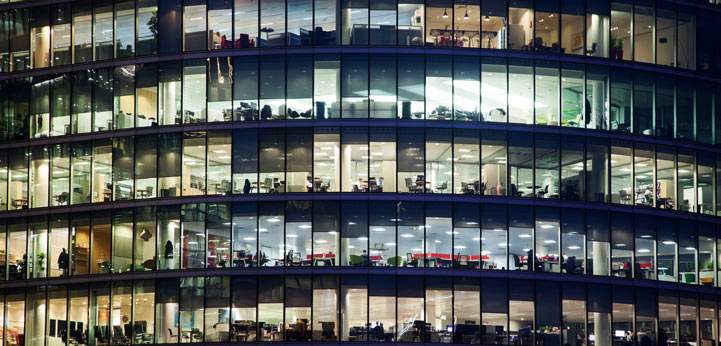Returning economic certainty, the global war for talent, and increasing desire for more sustainable and flexible options have encouraged occupiers to look for top-quality spaces in global cities
Taking flight (to quality)
As it stands, 2022 will be the third year the global economy is influenced by the Covid 19 pandemic, but it appears that influence is starting to fade. With the return of economic certainty, occupier decision making has moved from dealing with short-term lease events to planning for long-term growth.
The continual disruption and uncertainties caused by global Covid rules and policies at governmental and the corporate level has made it challenging for occupiers to navigate with any certainty their future employee and space requirements.
A strong trend observable across many markets has been the demand for talent retention and attraction and a focus on what role the office environment has to play in addressing these issues.
Whatever the company policy on hybrid working, the quality and location of the office is still seen as a primary factor for company culture and staff attraction. As a consequence, occupiers have been prioritising quality space in prime CBD locations, which did see increased concessions from landlords.
Flexibility has been a significant driver in many markets, with flex space seeing strong demand and conventional space increasingly requiring shorter leases or more regular break options, in part due to the rapidly changing environment.
Sustainability continues to rise in importance with many companies seeing their sustainability requirements as a must-have for any new office lease.
Each quarter, the Savills team of expert local tenant representation professionals and researchers present a snapshot of occupancy costs for prime office space across global markets critical to our clients.
For this issue of the new Savills Prime Office Cost (SPOC) insights, we spoke with the leading tenant agents and researchers in New York, London, and Hong Kong to get their insights on current market conditions and hear their advice for occupiers.
Quarterly highlights
Over the past year, the most notable highlight is London’s West End dethroning Hong Kong as the world’s most expensive office market, when all costs have been factored in. London’s West End rose to the top spot in the fourth quarter of 2020 and has remained top of the table since (see table, below).
Cities in the United States broadly saw flat or increasing costs over the past year, with the region as a whole increasing 2% year on year. However, there was no increase in net-effective costs from Q3 2021 as concessions remain incredibly high. Occupiers in the United States have been keen to bring workers back to the offices when it is safe to do so, and have been focusing on interior amenities that promote in-person collaboration and connections, as well as buildings with systems that support superior indoor air quality and wellness.
Most markets in the EMEA region saw declining total costs averaging -5% for the year in dollar terms, with currency fluctuations accounting for the majority of the fall. In local currencies, the region saw growth of 1.7%. Extended and repeated lockdowns across Europe have played a role in declining dollar costs as workers remain working from home and occupiers reassess their space needs.
The Asia Pacific region posted a 2% annual decline for the net effective cost to occupiers. However, cities have seen much more varied changes in costs, ranging from 5% in Shanghai to -11% in Delhi. Rapid economic growth across the region has encouraged occupiers to consider taking space in key cities.
However, supply has outstripped demand in some markets causing rents to fall and concessions to rise to attract tenants, notably in Hong Kong, which for years held the title of most expensive office market.
Regardless of region, there has been a very clear flight to quality as occupiers look to offer the highest quality spaces to draw workers back in, with prime and super prime offices often accounting for the majority of spaces transacted.

Market Insights
A select panel of Savills tenant representation professionals share their expert opinion on their markets
CITIES IN FOCUS
Q. What is the current state of play in your office market?
New York
Prime rents in new and renovated office buildings in the Midtown New York submarket performed remarkably well in 2021, considering the current environment. However, lease concessions – tenant improvements and rent abatement periods – are at their highest point, as landlords try to attract occupiers. Older assets, and those that haven’t been renovated, are not performing as well, so the key theme in the market continues to be the flight to quality.
Greg Taubin, Vice Chairman, Savills North America
Hong Kong
For a city that has long claimed the title of most expensive, we have seen overall market drops of slightly below 10% for the year for prime office rents. However, rental decreases were less in the fourth quarter than compared to earlier in 2021.
Ricky W.K. Lau, Deputy Managing Director, Office Leasing
London
Prime rents in London have remained static throughout 2021. There have been a few instances of super prime deals being concluded on the very best space in the city, demonstrating a trend of flight to quality. But as a general rule, office rents have remained flat in the Core West End. We are starting to see much greater focus on ESG credentials from occupiers, and the differences between new or refurbished Grade A and second hand Grade B stock is starting to widen.
Andrew Barnes, Director, Central London Tenant Representation
LOCAL SENTIMENT
Q. What advice would you give to occupiers looking to take space in your market?
New York
I would advise occupiers seeking prime office space in Midtown New York to fully vet the market alternatives, including scrutinising space efficiencies as well as the operating and real estate tax escalations. In addition, structuring flexibility and optionality into the transaction is of paramount importance.
Greg Taubin, Vice Chairman, Savills North America
Hong Kong
There is a lot of new office supply that will be completed in the next two years. These completions will likely continue to put prime office rents under downward pressure for that period. Tenants may feel no urgency to commit until closer to the lease expiry as they know there will be ample prime stock at potentially lower rents.
Ricky W.K. Lau, Deputy Managing Director, Office Leasing
London
For London’s West End, 85% of take-up has been for new or refurbished Grade A space, and with a finite supply of prime space and relatively limited development pipeline, committing well in advance of lease events is highly recommended if occupiers wish to secure top-quality spaces. Looking forward, we expect tenant incentives to start reducing and then for upwards pressure on rents for the best space to return.
Andrew Barnes, Director, Central London Tenant Representation

Outlook
Q What is likely to happen to rents in your region in 2022? Are there any cities to watch?
North America
Prime space continues to command a premium in North America, despite the ongoing pandemic. Occupiers are focussed on highly amenitised space designed to promote employee collaboration, satisfaction and retention. There will likely continue to be a bifurcation across North American markets between in-demand prime space and second-generation space that is likely to linger on the market.
San Francisco was one of the markets hit hardest during the pandemic. Some activity has resumed with the close of 2021, but a cycle of price discovery remains. While top-quality space will continue to price high, there is an abundance of space on the market and opportunities for tenants.
Sarah Dreyer, Vice President, Head of Americas Research
Asia Pacific
The region presented a mixed picture of largely muted rental growth in 2021 as markets were challenged by recurrent outbreaks, containment measures and subdued business prospects. Only China’s first-tier cities bucked the trend. In China, despite ample supply in 2021, a rebounding economy and a largely successful zero Covid policy spurred business expansion pushing down vacancy and stabilising rents.
For the region’s office markets, 2022 could yet prove to be a turnaround year as economies open up and the corporate outlook improves. New economy demand remains a bright spot. We note prospects for rental growth in Ho Chi Minh City, Seoul, Tokyo, Singapore and Beijing. In China, 2022 is likely to prove more challenging given even higher supply levels and continued business disruption from local Covid outbreaks, as well as potential debt events.
Simon Smith, Regional Head of Research & Consultancy Asia Pacific
EMEA
We continue to observe a polarisation in occupier demand between prime and secondary office buildings, so rental growth will be most prevalent for prime offices in CBD locations with good EPC ratings. Low vacancy rates, constrained development pipelines and recovering employment growth present rental growth opportunities across France, Germany and Benelux major cities.
Mike Barnes, Associate, European Commercial Research

Methodology
The Savills Prime Office Cost (SPOC) Index presents a quarterly snapshot of occupancy costs for prime office space throughout the world, as provided by our expert, local tenant representation professionals and researchers.
The adjusted annual all-in occupancy cost represents real-time transaction terms for 20,000 sq ft (2,000 sq m) of usable space based on a basket of top five most expensive properties to calculate ultra-prime average. The North American markets use a sample of very high rent threshold buildings (leasing occurring at the highest end of market).
All costs are reported in an annual, standardised format of USD per sq ft of usable space to account for variations in currency, reflect local payment protocols, and adjust for measurement practices across the globe. We have also factored in the credit value to the tenant generated from abated rent and the cost associated with fitting out the premises in order to provide an ’all in‘ total occupancy cost in USD per usable square foot.
The fit-out costs were gathered from local Savills teams assuming the leasing scenario described above, plus the following:
i) 30% cellularisation with the remainder of space open plan,
ii) construction and cabling only (no furniture or professional fees).
